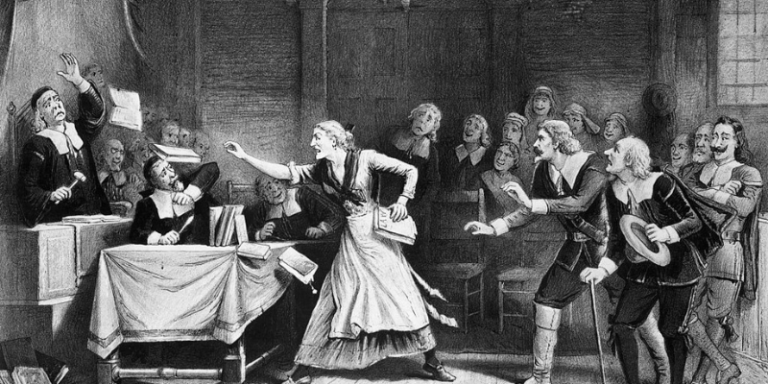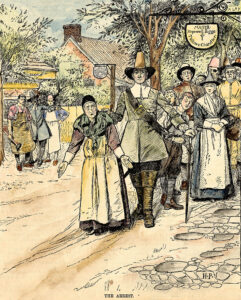Salem Witch Trials: When Being Called a Witch Meant Death
Being a witch for Halloween can be fun – but there was a time when that was a label to avoid.
By: Kelli Ballard | October 27, 2020 | 506 Words

Witch trial in Salem, Massachusetts. Lithograph by George H. Walker. (via Getty Images)
Dressing up as a witch for Halloween is popular among kids and adults as they take time adding warts to their noses and other witchy accessories. In fact, according to Google, a witch is the number one costume choice for trick-or-treaters. While being a witch one night a year is fun for today’s partygoers, the folks from 17th century Salem, Massachusetts had a completely different idea of anyone suspected of practicing witchcraft.
The folks in Salem took the Bible verse “Thou shalt not suffer a witch to live” (Exodus 22:18) very seriously. The Puritans were extremely religious people who believed the Church of England was too close to Catholicism and wanted to move away from the Catholic rituals and more towards the teachings of the Bible. Their beliefs and structure also made them less tolerant of anything that might break their strict rules. Unfortunately, many women and some men lost their lives after being accused of witchcraft during the Salem Witch Trials, which began in 1692.
In January 1692, Elizabeth (Betty) Parris, 9, and 11-year-old Abigail Williams became strangely ill, causing fear and confusion within the community. The girls were the daughter and niece of the minister of Salem Village, Samuel Parris. A local doctor diagnosed the pair, saying they had been bewitched. The children claimed they were being bitten and pinched by unseen forces. Soon, other young girls in the community started saying they had similar symptoms.

The Arrest.” Illustration (via Getty Images)
Betty and Abigail named three women whom they said were causing the affliction: Parris’s slave, Tituba; Sarah Osbourne, an invalid widow; and a local beggar woman, Sarah Good. The women denied the accusations except for Tituba, who said Satan had revealed himself to her. Her testimony started a massive witch hunt that would see near 200 people accused of witchcraft – including Good’s four-year-old daughter – and resulted in 20 executions.
The first official case heard in the special Court of Oyer (to hear) and Terminer (to decide) was against Bridget Bishop, a widow who had been accused of witchcraft years earlier but never convicted due to lack of evidence. Ten people testified against her this time, and she was found guilty.
In August, Martha Carrier was brought before the court. Her family was already unpopular as it was believed they had brought smallpox to Andover. Carrier was executed on August 19 along with Reverend George Burroughs, whom the villagers thought was the ringleader of the witches and three other men.
Martha Cory, an upstanding member community and church member, went to trial in September. After she had tried to prevent her husband, Giles, from participating in the witch trials, folks became suspicious of her and one of the girls accused Martha of making her blind. Her husband even testified against her. Giles, however, found himself being questioned for witchcraft.
Thankfully, the trials did not last long, but the story of the fanatical craze that swept the area and resulted in the executions of women and men has remained centuries later.
















